Another college football season is upon us. I thought Postcard History’s readers would enjoy another trip across America to view college football stadiums captured on postcards. The postcards date from the 1920s through the 1960s.
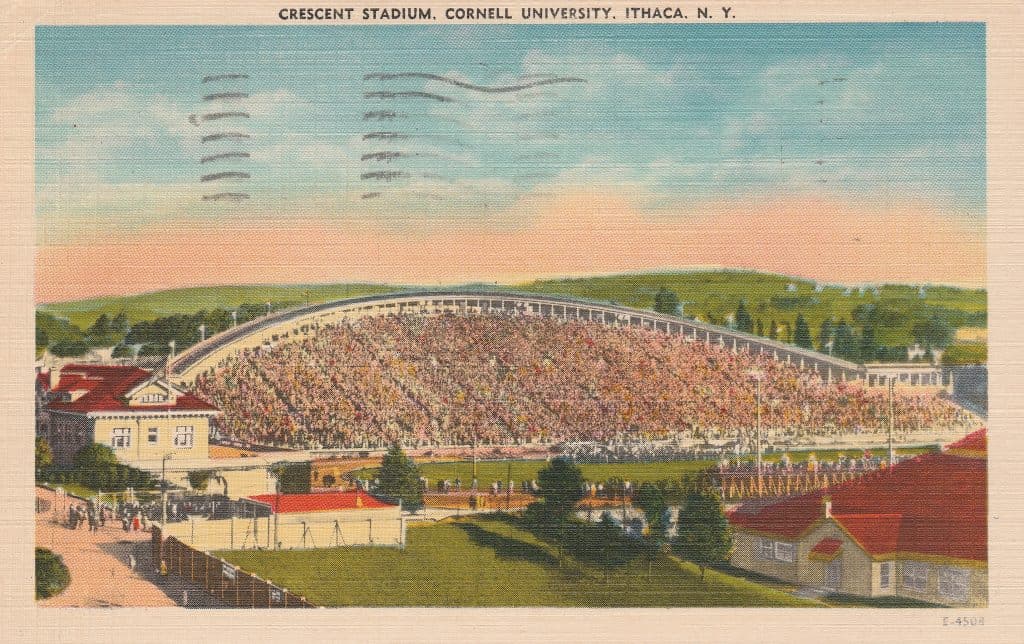
Today’s football fans do not think of the Ivy League as a major influence on college football, but the first football stadiums were built for Ivy League schools and had a major influence on early football stadium design.
Completed in 1915, Schoellkopf Field at Cornell University is one of the oldest college football stadiums in the U.S. It is named in honor of Henry Schoellkopf, a former Cornell football player and coach who died in 1912. When it was completed, it seated 9,000 fans. After an expansion project in 1924, the capacity increased to 21,500. The stadium is unusual in that all the seating is on the east side of the field. In 1947, steel bleachers were erected on the west side of the field adding 4,000 seats. However, the bleachers were torn down in 2016 after they fell into disrepair. A press box and a parking deck, constructed in 1986, are all that remain on the west sideline today.

Franklin Field, on the campus of the Ivy League’s University of Pennsylvania, is the oldest college football stadium in the U.S. The first grandstand was erected in 1895 for 30,000 fans. The current structure was built in 1922 and expanded in 1925 making it then the largest college football stadium in the U.S. seating 65,000. The first televised college football game was broadcast from Franklin Field in 1939. It was the home of the NFL Philadelphia Eagles from 1958 until 1970. The Army-Navy game was played here eighteen times between 1899 and 1935. It is also home to the Penn Relays track meet. After a renovation from 2015 to 2020, the seating dropped to 52,958.
Although not the home field of a college football team, Soldier Field still played an important role in the history of college football. Located in Chicago’s Grant Park on Lake Michigan, Soldier Field was completed in the summer of 1924, and cost $13 million to construct. By comparison, the Los Angeles Coliseum built in 1923 cost only $954,873. It was initially named the Municipal Grant Park Stadium, but the name was changed on November 11, 1925, to honor soldiers who died in World War I. It initially seated 74,000 spectators; seating was later increased to 100,000 with temporary stands.
The stadium is designed in the Neoclassical style with Doric columns adorning the East and West entrances to the stadium. It was one of several great sporting venues built in the United States during the 1920s Golden Age of Sports. Incidentally, the obelisk shown on the postcard was never built.
Notre Dame defeated Northwestern University in 1924 by a score of 13 to 6 in the first college football game played in Soldier Field. In November 1927, the Notre Dame Fighting Irish played the University of Southern California Trojans before a crowd of 123,000, a record for college football that stood until 2016. Notre Dame beat USC 7 – 6 in that game. In 1929, Notre Dame played its home games at Soldier Field while its new stadium was under construction in South Bend.
Chicago hosted the November 1926 Army – Navy game that attracted 100,000 fans to Soldier Field. Navy was unbeaten while Army had lost one game. Many anticipated that the game would determine the national championship. The game ended in a 21 – 21 tie.
From 1934 to 1976, Soldier Field hosted the preseason Chicago Charities College All-Star Game, a game featuring college standouts against the NFL champion. During the 1920s and 1930s, college football dominated the nation’s sports pages. The struggling NFL needed a boost from the immensely more popular college game. On August 31, 1934, a crowd of 79,432 watched the college all-stars battle the Chicago Bears to a scoreless tie. In 1935, future U.S. President Gerald R. Ford played for the college all-stars. Baseball Hall of Famer, Jackie Robinson, was one of the all-stars in the 1941 game. Attendance exceeded 100,000 for the 1942, 1947, and 1948 games and was over 90,000 for the 1941, 1945, 1946, 1949, 1951,1953, and 1954 games. The Pros won thirty-one games, the All-Stars won nine games, and there were two ties. Before a crowd of 65,000 in 1963, the All-Stars won for the last time beating Vince Lombardi and the vaunted Green Bay Packers.
On September 22, 1927, Gene Tunney defeated Jack Dempsey in front of 104,000 spectators to retain the heavyweight title. Tunney had defeated Dempsey in 1926 to become the heavyweight champion. The gate receipts were $2,658,660, the first time in the Unites States that an entertainment or sporting event grossed over $2 million. During the 1944 election campaign, President Franklin Roosevelt addressed a Soldier Field crowd estimated at 150,000 people.
The NFL Chicago Bears moved from Wrigley Field to Soldier Field in 1971. Soldier Field was rebuilt from 2002 to 2003 and no longer resembles the 1920s Neoclassical gem.

David Booth Kansas Memorial Stadium at the University of Kansas in Lawrence opened in 1921. It is the seventh oldest college football stadium in the nation. Like many stadiums built in the 1920s, it was dedicated as a memorial in honor of University of Kansas students who died in World War I. In 2017, it was renamed for David G. Booth, an alumnus who pledged $50 million for the stadium’s rebuilding. The home of the Kansas Jayhawks, the stadium seated 22,000 when built but expansion projects in 1927, 1963, and 1965 have increased capacity to 47,233. A record attendance of 52,530 was set in 2009 when the Jayhawks defeated Northern Colorado in the season opener. Demolition of the stadium began at the conclusion of the 2023 season. The Jayhawks will play their 2024 games in Kansas City and a new stadium will be completed in time for the 2025 season.
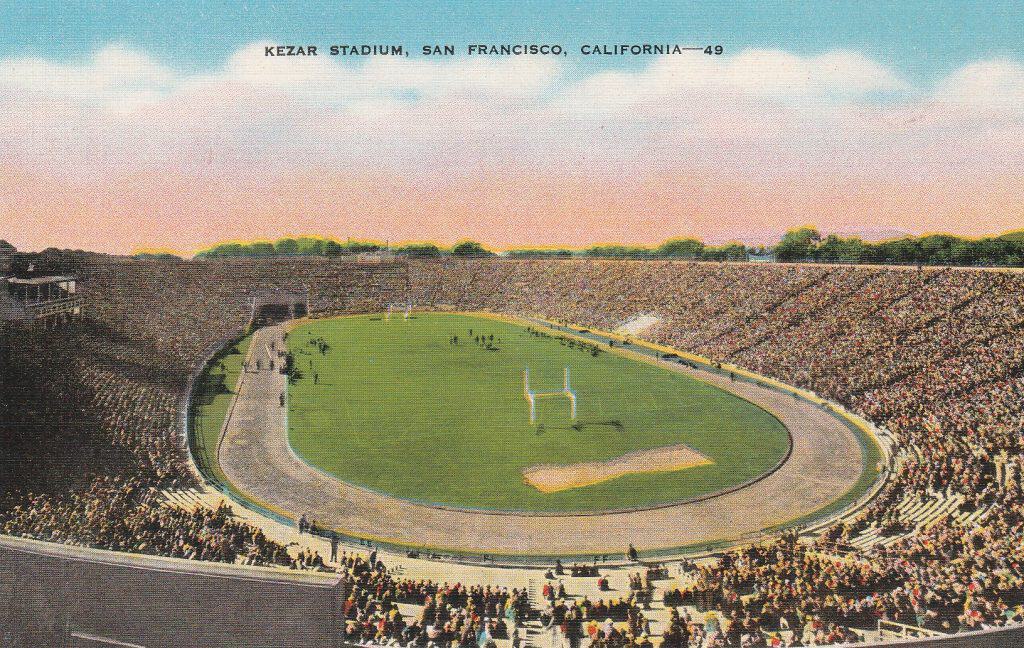
Located in the Southeastern corner of Golden Gate Park, Kezar Stadium in San Francisco opened in 1925. Seating 50,000 spectators, Kezar was another large municipal stadium built during the Golden Age of Sports. It was home to Santa Clara University Broncos from 1935 until 1952, Saint Mary’s College Gaels from 1927 until 1950, and the University of San Francisco Doms from 1930 until 1951 and again from 1959 until 1971. The stadium was also the home for almost forty years to the postseason East-West Shrine Football game played between college all-stars. Kezar served as the home of NFL San Francisco 49ers from 1946 until 1970. The AFL Oakland Raider played their first season, 1960, in Kezar. Kezar was torn down in 1989 and replaced with a 10,000-seat stadium for track events and high school football. Movie buffs will remember Clint Eastwood shooting the Scorpio killer on the playing field in the 1971 film, Dirty Harry.
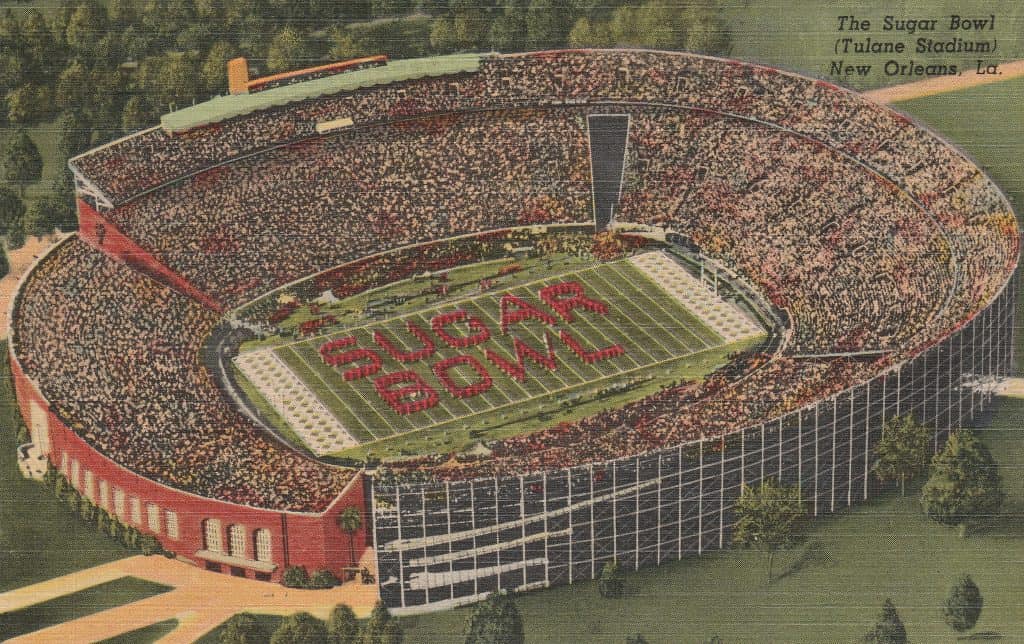
Located on the campus of Tulane University, Tulane Stadium was built in 1926 and seated 35,000. After the first postseason Sugar Bowl in 1935, the stadium became informally known as the Sugar Bowl as well as earning the nickname, the Queen of Southern Stadiums. Due to the popularity of the Sugar Bowl, expansion projects in 1937, 1939, 1947, and 1955 increased capacity to 80,895. The Sugar Bowl moved to the Superdome in 1975.
In 1973, the Tulane Stadium set two attendance records. A regular season game on December 1, 1973, between Tulane and LSU drew 86,598 fans, and the Sugar Bowl, played on New Years Eve, before 85,161 fans who saw Notre Dame defeat Alabama for the National Championship.
Tulane Stadium was the home of the NFL Saints from 1967 until 1974. It also hosted Super Bowls IV, VI, and IX. After the Tulane Green Wave and the Saints moved to the Superdome, Tulane Stadium was demolished. After poor attendance at the cavernous Superdome, the Green Wave moved back to the Tulane campus in 2014 to newly constructed Yulman Stadium that seats a mere 30,000 fans.
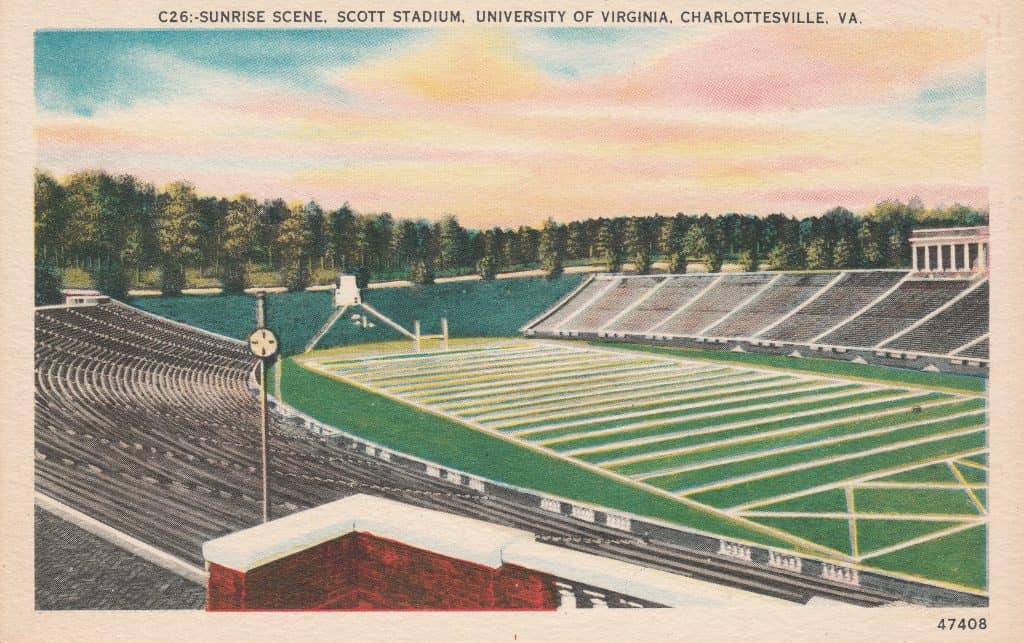
Scott Stadium at the University of Virginia opened in 1931 and initially seated 25,000 fans. When it was built, the open south end of the stadium offered a view of the Blue Ridge Mountains, and many considered it to be one of the most beautiful stadiums in the country. Student spectators sat on the hills in the end zones. There were very few changes to Scott Stadium over the next forty years.
Several expansion and renovation projects between 1980 and 2000 increased capacity to 61,500. Upper decks were added to the east and west sides of the stadium. Two levels of seating were added to the southern end of the stadium and the northern hillside was tiered to make it safer and more accessible for student spectators.
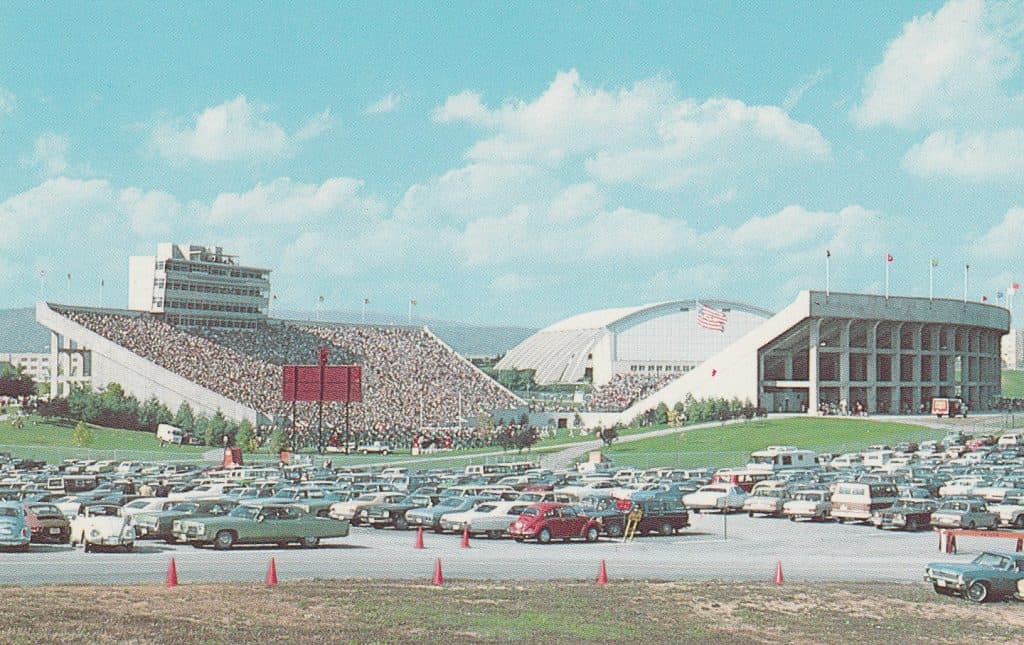
Virginia Tech’s Lane Stadium was completed in 1968 after four years of construction. The first game was played in 1965 while the stadium was still under construction, Tech beat William & Mary. The stadium was named for Edward Lane, a Virginia Tech graduate and benefactor who made his fortune as a manufacturer of cedar hope chests. In 1980, capacity increased to 52,500. Capacity is currently 65,353 with 1,200 in club seating and 240 in 15 luxury suites after a series of renovations between 1999 and 2004. At an elevation of 2,057 feet above sea level, Lane Stadium is the second highest stadium in the Eastern United States. Appalachian State [in North Carolina] is the highest at 3,333 feet above sea level. War Memorial Stadium at the University of Wyoming in Laramie has an elevation is 7,215 feet above sea level, making it the highest college football stadium in the country.
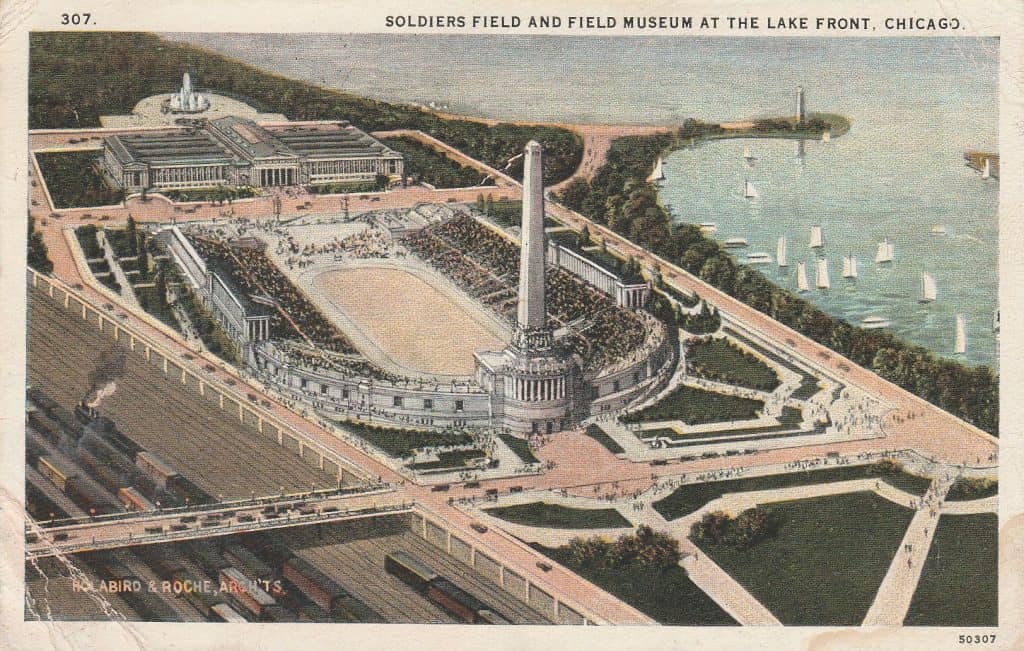
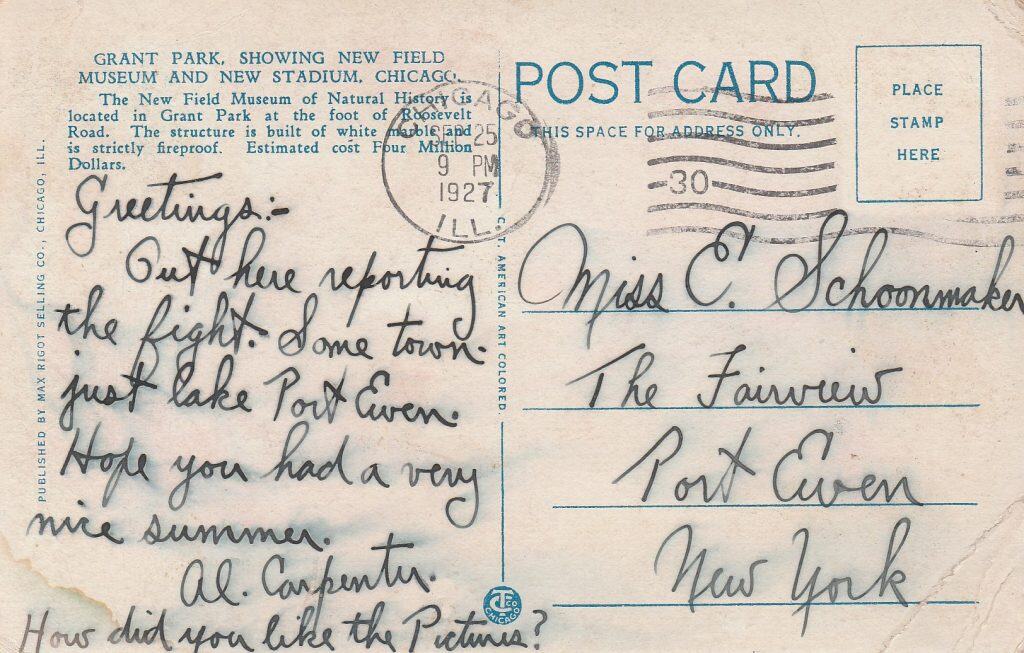
I noticed that the Chicago card erroneously refers to Soldier Field as “SOLDIERS FIELD”.
Another postcard publisher error. I also have a 1930’s linen card that has the same spelling error.
Great article. Dan Always provides such interesting facts to accompany the cards. He is quite the expert on college stadiums.
This is really interesting. It’s amazing how many college football stadiums there are in the U.S. and the size of some of them. Most of the cards seem content to impress us with the size of the stadium via an aerial view rather than bringing us into the action with an up-close image of football being played. I guess that makes sense given the level of pride that was taken in the facilities themselves.
Being a sports fan I became interested in early 1900 stadiums and sporting event post cards. A few years ago I began including them are part of my collection. Interesting article and history of these stadiums. Learned a few things also.